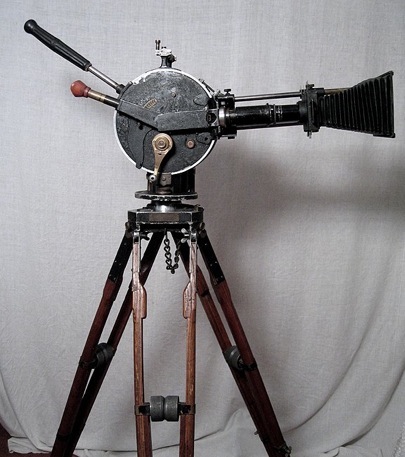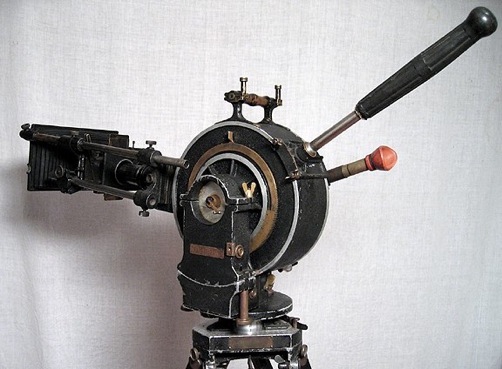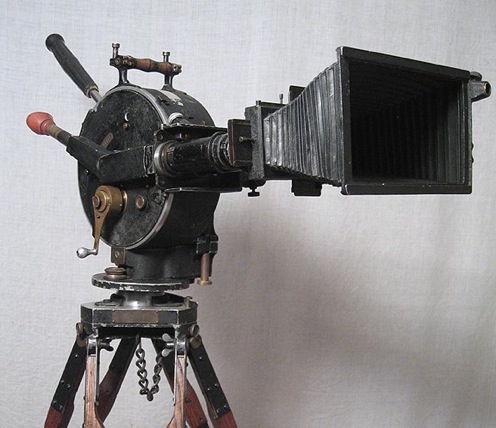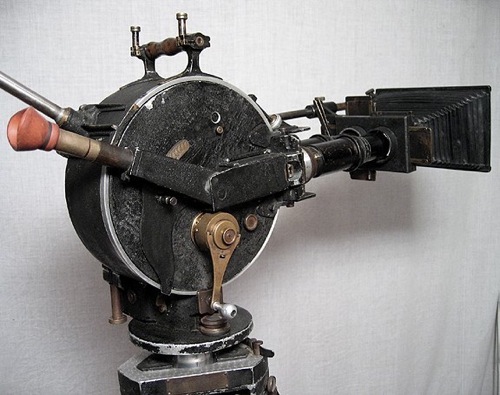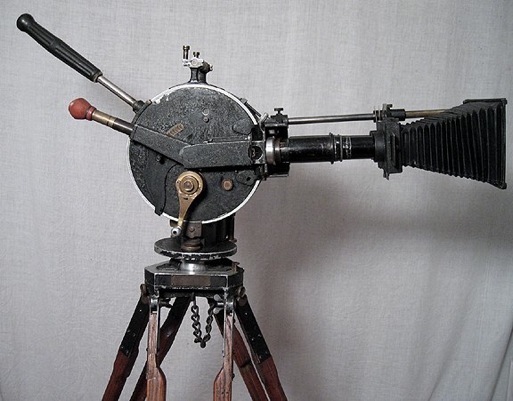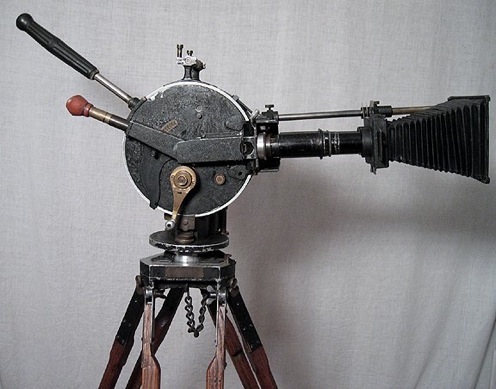
Land Speed Record Akeley
SOLD
This camera found a new caretaker before I could post it to this website.
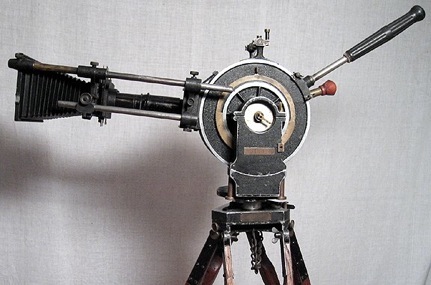
The Akeley Camera Company made just slightly over 400 cameras. I don’t imagine there are a hundred complete cameras left. Actually, from what I have seen in collections around the world, the number is probably under forty.
Carl Akeley first toyed with a movie camera design in1906. He then devoted every minute of his spare time developing his final camera between 1910 and 1916. His genius coupled with his research and development brought an amazing camera to the point of manufacture in 1916.
There are two cranks on this Akeley. One is the main shooting crank and the other is a single frame crank. It is quite unusual that the single frame crank is still with this camera. It can be seen in the center of the camera left side. As with all hand-cranked cameras, the main crank is turned at two times a second to get 16 fps. The single frame crank is for time-lapse. One turn of the crank is one frame.
Serial number 100 is an incredible Akeley and is probably from around 1920. As you will see later it has the most complete set of unique accessories for an Akeley camera I have ever seen. This camera worked the Bonneville Salt Flats during many land speed record runs in the 1930’s and 1940’s. It seems like the cameraman shot his last footage with it and put the camera away where it has been for over 60 years.
(There is actually film footage this camera shot during the land speed record attempts.)
The camera belonged to John R. Olsen who shot several years of land speed records and years of Newsreels for Pathe, Universal, MGM and Fox Movietone News along with footage for his local theaters.
He was a well-known action cameraman in his time. He was well known and highly respected within the ranks of the special breed of adventurous cameraman who shot the news of the day. Of all his year after year assignments he loved going to the Salt Flats the best. He became a well known regular and filmed Sir Malcom Campbell and Ab Jenkins, owner/driver of the 1935 Mormon Meteor, in the '30s and John Cobb, George Eyston, & Ab Jenkins again in the late '40s. He often shot from a high-speed camera car.
Mr. Olsen knew what equipment would work best so his camera set has really long lenses and the most complete set of filters I have ever seen with any antique camera. With the (250mm and the 17 inch/432mm) Mr. Olsen could follow really high-speed action at a safe distance. One couldn’t shoot quality action on The Bonneville Salt Flats with any other kind of set up. No camera had dual sets of matched lenses, one for the cameraman to look through and the other to capture the images on film. No other camera had two sets of gyro planetary gears in the tripod head so high speed action could be followed smoothly and successfully. No other camera and head would give a DP useable footage like the Akeley setup did.
Many cameramen became well known specialists with their Akeley cameras. These specialists were the Steadycam operators of their period. The Akeley was such a popular camera that Hollywood movies often had a call for “Akeley Shots” written right into the script. This is the kind of camera that was first choice for aerials as seen in “Wings” and “Hells Angels” and camera car work shot on the ground. Several studios converted Cadillac sedans into camera cars. They took the body off and made a wooden flat bed on the chassis so they could mount cameras anywhere and everywhere. This camera is so versatile that it would shoot from a high-speed camera car and then could be shooting on the ground less than a minute later.
There is a large stage screw with tiedown chains and a turnbuckle in this cameras’ set of accessories. The tiedown screw or stage screw would screw directly into the wood bed of the camera car and then the chains and turnbuckle would pull the tripod down securely to the camera car. Cadillacs gave the best ride of all the cars made from around 1915 through 1940. I know of one 1923 Cadillac camera car that is under restoration at the moment. I’m excited to see it and I’m positive an Akeley will be chosen to be on the car when its finished. Using any other camera would not be correct.
No camera today or in the past has a shutter angle larger than an Akeley camera did in 1916. A shutter opening over 180 degrees was unheard of, as the mechanics of motion picture camera mechanisms wouldn’t allow for more than that. On all other movie cameras the shutter was a metal rotating disk between the lens and the film and usually 170 degrees or less. On the Akeley camera the focal plane shutter is a curtain and rotated all the way around the outside of the camera, thus the unusual and unique circular camera body. It allowed the Akeley camera to have a really large shutter angle of 230 degrees. Akeley cameras gave a cameraman the ability to shoot at lower light levels than other cameramen. They could shoot earlier in the morning and later in the evening. There is not now nor has there ever been a motion picture camera with a shutter opening of more than 205 degrees, other than an Akeley. By the way, the camera with a 205-degree shutter is contemporary, new, right now and comes with a recommendation that it rarely be used, as there is some movement of the film before the shutter is completely closed.

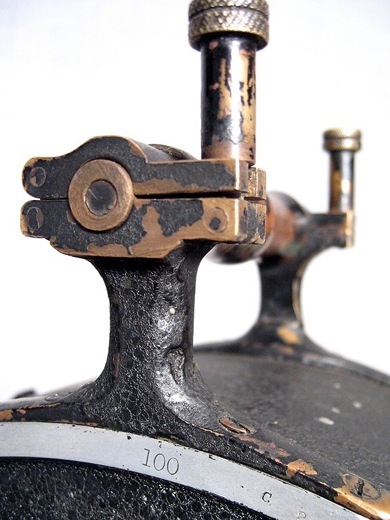
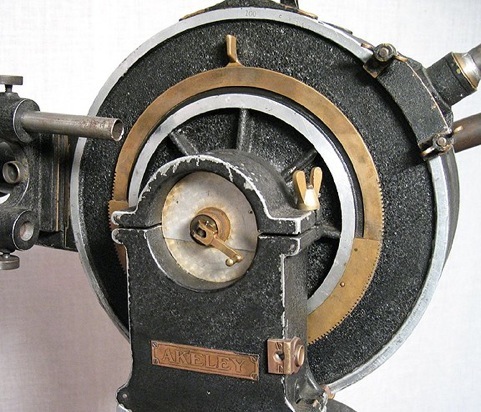
As you can see from reading around my web site I have seen hundreds of antique motion picture cameras. I disassembled this Akeley matte box to clean, lubricate and preserve it and discovered that I have never seen anything like this before. The matte box for this Akeley is amazing. It has filter holders for each lens so the operator can look through his lens and see just what image is going on to the film through the other lens.
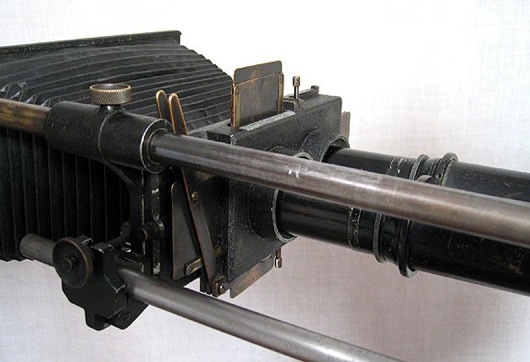
It has the most unbelievable set of top and bottom and side to side nets. The nets are for the taking lens only. Most Directors of Photography would place a net over the entire lens but this camera shot on the Salt Flats so the DP could place a net down from the top to cover the ultra bright sky. There is an identical net he could bring up from the bottom of the scene to cover the even brighter white salt leaving a gap between the two to have the racing car in the open strip in the middle. It has solid mattes to completely block the sky or salt or both. It has spring loaded filter holder stations so he could put neutral density filters over all. It has an unusual set of filters mounted in metal holders that fit the spring mounted stations in the matte box. It is the most versatile matte box I have ever seen and the only Akeley matte box I have ever seen. It is designed for the long lenses in the lens set.
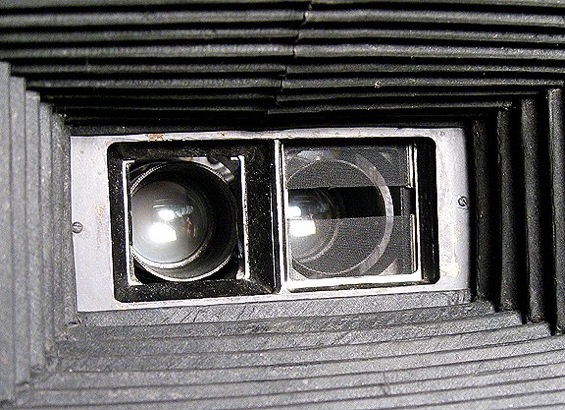
The design of the Akeley head was beyond innovation, it was genius. One could set a tripod in place and not care if the tripod was level. There is a ball-leveling device built into the head where you just flipped a lever and leveled the head and camera independent of the tripod. This Akeley owner also added a tiedown chain so he could place the tripod on a camera car and chain it to the deck for high speed runs. The head also detaches from the tripod quickly so it can be placed on the ground and becomes a hi-hat and head in less than thirty seconds.
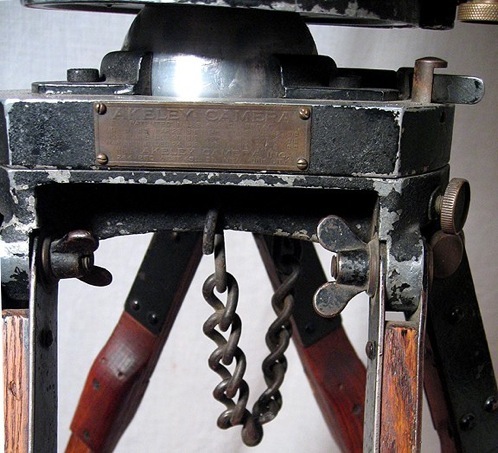
Here is a picture of the very versatile six lens set. Each lens set cost around $200. This made the price of the camera and lenses around $3,000. You could have bought a very nice house for that much money.
The lenses are:
Carl Zeiss Jenna Tessar 50mm
Carl Zeiss Jenna Tessar80mm
Bausch and Lomb114mm
Dallmeyer152mm
Carl Zeiss Jenna Tessar250mm
Dallmeyer432mm
This is a wonderful set of filters and metal filter holders. The white cloth at the top of the picture is filled with metal filter holders in each little pocket that snap into the matte box. There is a Kodak lens cleaner bottle and a couple of packs of lens tissue. There are eight Wratten Gelatin filter packs with three inch filters in each.
The inside of this Akeley is beautiful. I have taken the door apart and lubricated all the mechanism and lubed the movement. It was lubed before being put away so there is absolutely no rust in this camera anywhere.
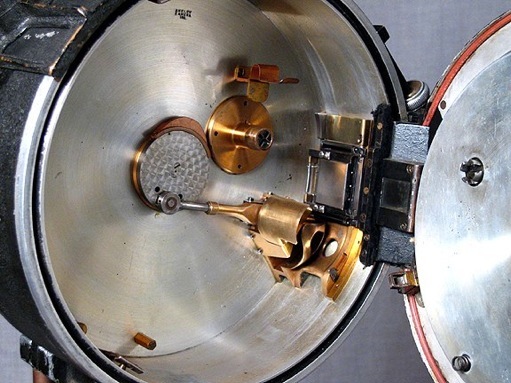
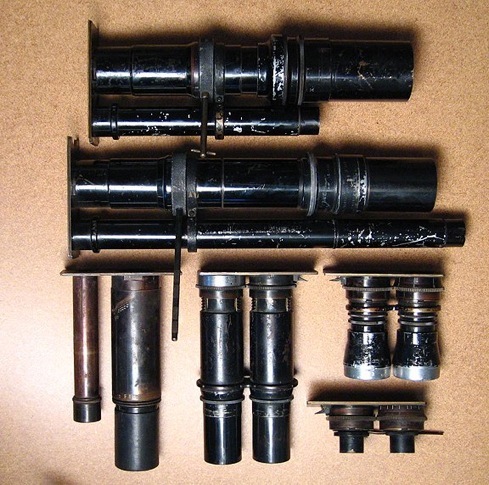
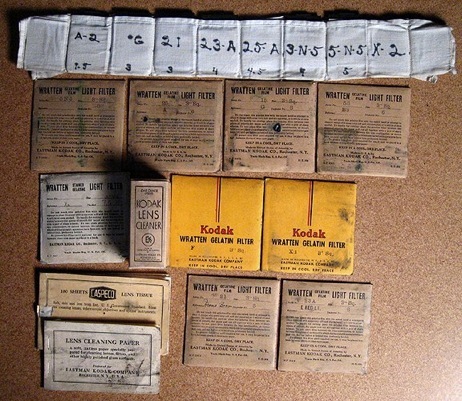
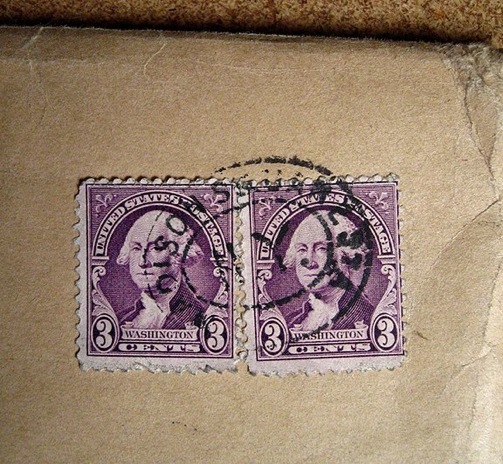
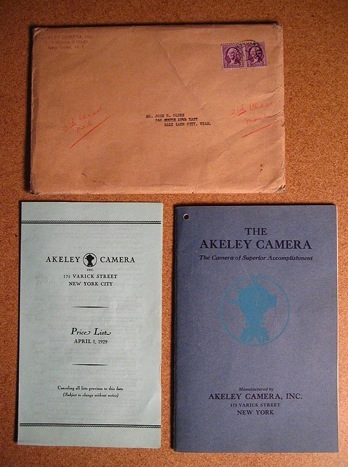
There is an original Akeley owner’s manual and a price list. These were mailed to the new owner for the impressive cost of six cents.
I have seen many museums’ movie camera collections. This camera set quality is quite a bit above any museum Akeley. Let’s take a tour around the camera:
